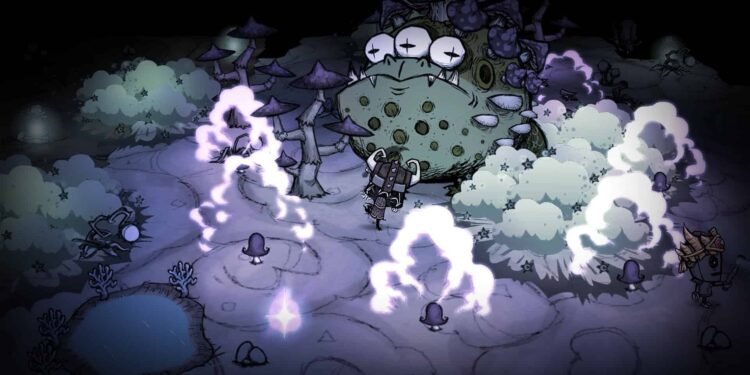Surviving in the harsh and unforgiving world of Don’t Starve Together can be a daunting task, especially if you are playing solo. While the game is primarily designed for multiplayer experiences, you can also take on the challenge all by yourself! When you do so, finding the optimal settings for a solo playthrough becomes very important. That being said, in this guide, we have shared the best single-player settings for the game to make sure you have a balanced and enjoyable journey through the wilderness in Don’t Starve Together.
Choosing the right settings for solo play becomes all the more important as you don’t have other players to help you find food, fight enemies, or bring you back to life. With the right settings, the gameplay can be a tad bit easier or harder, depending on what you like. You can adjust how much food there is, how tough the enemies are, how bad the weather gets, how long the days and nights last, etc. So, let’s get right into the details.
Best Don’t Starve Together Single Player Settings (2024)
- World Gen (Biomes): Classic
- World Gen (Spawn Area): Default
- World Gen (Size): Small
- World Gen (Branches): Default
- World Gen: (Loops): Never/Default
- Events: Auto
- Autumn: Long
- Winter: Default
- Spring: Default
- Summer: Default
- Starting Season: Autumn
- Day Type: Longer Days
- Rain: Default
- Lightning: Default
- Frog Rain: Low
- Wildfires: Low
- World Regrowth: Default
- Touch Stones: Default
- Failed Survivors: Default
- Disease: Default
- Starting Resource Variety: Classic
- Forest Petrification: Default
- Flowers, Evil Flowers: Low
- Grass: Default
- Saplings: Default
- Spiky Bushes: Low
- Tumbleweeds: Default
- Reeds: Default
- Trees (All): Default
- Flint: Default
- Boulders: Default
- Mini Glaciers: Default
- Meteor Fields: Low
- Meteor Frequency: Low
- Berry Bushes: More
- Carrots: More
- Mushrooms: More
- Cacti: Default
- Rabbits: Default
- Moles: Default
- Butterflies: More
- Birds: Default
- Buzzards: Default
- Catcoons: Default
- Gobblers: Default
- Pigs: Default
- Volt Goats: Default
- Beefalos: Default
- Beefalo Mating Frequency: Default
- Hunts: More
- Hunt Surprises: More
- Pengulls: Default
- Ponds: Default
- Bees: More
- Killer Bees: Low
- Tallbirds: Default
- Spiders: Low
- Hound Attacks: Low/Disable
- Hound Mounds: Default
- Merms: Default
- Tentacles: Low
- Clockworks:Default
- Lureplants: Default
- MacTusk Camps: Default
- Treeguards: Default
- Poison Birchnut Trees: Default
- Krampii: Default
- Bearger: Default
- Deerclops: Default
- Meese/Geese: Default
- Dragonfly: More
- Antlion Tribute: Default
Recommended Settings by Players
Here are some settings and recommendations from solo players that have been positively received:
- Enemy Health Scaling Mod: Adjusts enemy health to be more manageable for solo players, maintaining challenge without overwhelming difficulty intended for multiple players.
- Starting Resource Variety: Setting this option to Classic will make the resources, such as carrots or berry bushes, much more abundant so that you have an easier time during the early game phase.
- Event Frequency Adjustments: Lower the frequency of events like hound attacks or frog rain to reduce unexpected challenges.
- World Size and Complexity: Many players have pointed out that generating a large world with small caves is the best approach to take. Also, turn off cave monkeys and wildfires!
- Season Length and Severity: Also, extending the length of days or mild seasons can provide more time for preparation and exploration before harsh conditions set in.
- Harvest Multiplier: Set it to 2.5 or 5 to increase resource yield, depending on how much grinding is desired.
- Harvest Respawn Rate: Reduced to the minimum to allow for faster farming and resource regeneration.
- Craft Time Multiplier: Decreased significantly to speed up crafting processes.
- Fuel Consumption Multiplier: Reduced to ensure fuel lasts longer without frequent refueling.
- Food Spoil Rate: Adjusted to approximately half of the default rate to slow down food spoilage.
- XP Multiplier: Lowered initially to slow progression through levels, with a potential increase after reaching level 30.
Since these settings are subjective, starting with default settings is what we recommend, and then you can make the changes we have mentioned above. Once you’re familiar with them, feel free to tweak the other settings to fit your style. Just keep in mind that making too many changes can throw off this balance so proceed with caution.
And that is all we have to share regarding the best settings for solo play in Don’t Starve Together. We hope this was helpful! Stay connected to Digistatement for more gaming guides and news like this! Read more: Primehack Steam Deck Controls Not Working: How to fix it?


